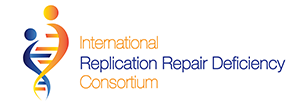Information for Patients and Families
Is cancer hereditary?
Everyone can potentially develop cancer in their lifetime. As we get older, the cells that line our organs are damaged by environmental factors, such as diet, lifestyle and aging.
Over time, this damage adds up and can lead to cancer diagnosis. This defines most cases of cancer, which we call sporadic (happens by chance). A smaller number of cancers are explained by a hereditary factor (something running in a family) that increases one’s risk of cancer.
We’ll cover the basics of the hereditary cancer condition called Constitutional Mismatch Repair Deficiency or CMMRD, including cancers associated with CMMRD, background genetics and the testing process.
What is Constitutional Mismatch Repair Deficiency?
CMMRD (Constitutional Mismatch Repair Deficiency) is very rare genetic condition which increases a person’s risk of developing cancer at very young ages, starting in childhood.
Constitutional means both copies of the gene are affected.
Mismatch Repair refers to the types of genes impacted.
Deficiency means “not working.”
What types of cancer are seen in CMMRD?
The main types of cancers seen in children with CMMRD are brain and central nervous system, blood (lymphoma and leukemia) and digestive tract cancers (colon, small bowel).
Individuals affected with CMMRD may also develop small growths in the digestive tract called polyps, and if not removed, that can develop into cancer.
There have been reports of other types of cancers in CMMRD, but these are the most common.
What causes CMMRD?
CMMRD is hereditary, meaning that it can be passed down from parents to child through genes. Genes carry instructions to help our body work properly. There are two copies of every gene, one you inherit from mom and the other from dad.
There are five genes currently associated with BMMRD. These genes are known as mismatch repair genes or MMR genes, because they repair any genetic mismatches that can happen when our cells grow and divide. If they don’t work properly, a cell may grow out of control, which results in cancer.
The five mismatch repair (MMR) genes are:
- PMS2
- MSH6
- MLH1
- MSH2
- EPCAM
What’s the relationship between CMMRD and Lynch syndrome?
We know that a person with CMMRD has mutations in both copies of their mismatch repair (MMR) genes – one they inherited from mom and the other from dad. This means both mom and dad have a mutation in one copy of their mismatch repair (MMR) gene.
Having a mutation in one copy of the MMR gene causes a genetic condition called Lynch syndrome or LS.
Individuals with Lynch syndrome are at higher risk to develop colorectal and endometrial (womb) cancer in adulthood. Other types of digestive, urinary tract and ovarian cancers have been seen in Lynch syndrome patients, but they are much rarer.
Even though both parents have Lynch syndrome (which was probably running through generations of the family), most CMMRD families do not have a strong history of cancer.
Since both child and parents have different genetic conditions, cancer screening and surveillance recommendations are tailored to reduce the chance of developing cancer.
How is CMMRD inherited?
If both parents have Lynch syndrome, there is a 25% chance to pass on CMMRD with each pregnancy. This is called autosomal recessive inheritance.
There is also a 50% chance for each pregnancy to inherit Lynch syndrome (like mom and dad) and a 25% chance to inherit no MMR mutation.

How does genetic testing work?
A person referred to a genetics clinic will be asked to give family history and all medical information. If a family is suspected of having CMMRD, genetic testing may be offered.
Steps in genetic testing for CMMRD
- Look at tumor samples. Most tumors associated with CMMRD show special characteristics. If these characteristics are seen, then we move on to the second step: genetic testing using a blood sample.
- Genetic testing looks for a mutation in one of the five genes that are known to be associated with CMMRD. If mutations are found in both copies of the gene, then CMMRD is confirmed. At that point, relatives can be tested to see if they have CMMRD, Lynch syndrome or no MMR mutation.
Sometimes the testing process does not find a mutation in a family. In these cases, we may not be able to confirm or rule out a hereditary cancer syndrome. Still, we may be highly suspicious based on the types of cancers reported, the preliminary tumour test result and features like café-au-lait macules.
